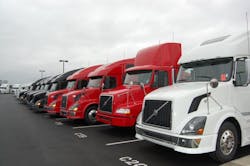IHS: Both fleet age and truck demand on the rise
Even as the strengthening economy keeps driving up demand for both new and used trucks, the average age of fleet vehicles continues to trend up, according to Gary Meteer, director of commercial vehicle solutions for IHS Automotive, which provides research and analysis services.
While registrations for used trucks still outnumber those for new ones, overall demand for commercial vehicles in both the U.S. and Canada “continues to strengthen,” Meteer stated in his remarks this week at the Automotive Aftermarket Products Expo (AAPEX) in Las Vega.
“With more than 7.7-million commercial vehicles on the road in the U.S., the market here is at its highest levels since the 2008-09 economic downturn,” he pointed out.
More specifically, Meteer said that Class 8 vehicles “continue to dominate both the U.S. and Canadian markets,” accounting for more than a 50% share of new registrations in the U.S. and over 60% in Canada.
On the other hand, he stressed that “with the overall market recovery, Class 5 straight trucks and chassis-cabs have been in high demand for modifications and use in the wholesale, retail and service industries. “In the current calendar year, the demand for these vehicles is at record levels.”
As Meteer put it, it’s “not surprising” that the recovery in the commercial vehicle market in both countries is being “largely driven by the business community.”
He said U.S. businesses have accounted for more than 90% of new vehicle registrations so far this year.
According to IHS Automotive, the south and central regions of the U.S. stand out as the strongest markets for trucks, representing more than 62% of new vehicle registrations so far this year. In Canada, the four provinces of Alberta, British Columbia, Ontario and Quebec “account for more than 87% of new commercial vehicle registrations and additional growth is expected.”
Then there are all those aging trucks. Metter said “the average age of commercial vehicles in the fleet is shifting.” IHS Automotive has determined that while the average age for Class 4-8 vehicles was 12.5 years in 2007, that figure now stands at 14.7 years
What’s more, the subset of Class 6 vehicles is averaging 20.9 years -- the highest in the fleet. Conversely, the average age of Class 5 is just 11.9 years— making them the youngest in the fleet. Meteer noted that is due to this GVW segment’s “historical low demand.”
IHS Automotive has also determined the leasing and rental of new trucks has gone up “substantially since 2000,” especially for Class 4 and Class 6 trucks.
Meteer advised that “just over 40% of Class 6 vehicles are leased today, compared to less than 30% in the 2000-2013 timeframe. Leasing rates for GVW 4 vehicles have also substantially increased, from less than 20% in 2000-2013 to more than 30%.”
On the other hand, he said that Class 7 leasing is up only “marginally, from 15.1% in 2000-2013 to 19.5% in 2014.” As for Class 5 and 8, leasing activity in those segments has “remained relatively flat” over the same time period.
“The renewed strength of the rental/leasing segment of the commercial vehicle market is a good sign that business owners are positive about their business needs and the ongoing demand for their services,” Meteer remarked.
Another interesting finding by IHS Automotive that Meteer related: While over 48% of the Class 4-8 commercial vehicles in the U.S. are run by small [10 trucks or less] fleets, those trucking operations account for only about 22% of new registrations.
“This speaks to the ongoing strong demand for clean used vehicles that are used by small- and medium-size businesses to handle their business needs,” said Meteer. He added that, in this regard, Class 4 trucks are “the most prominent.”
Looking beyond the big numbers, Meteer also advised aftermarket suppliers in the audience to bear in mind that “there are many different uses for commercial vehicles, and each has their own dynamic circumstances and opportunities.
“It is increasingly important for suppliers… to better understand the market they serve and recognize that nuances for each category exist and provide opportunities for business development and growth,” he added.
